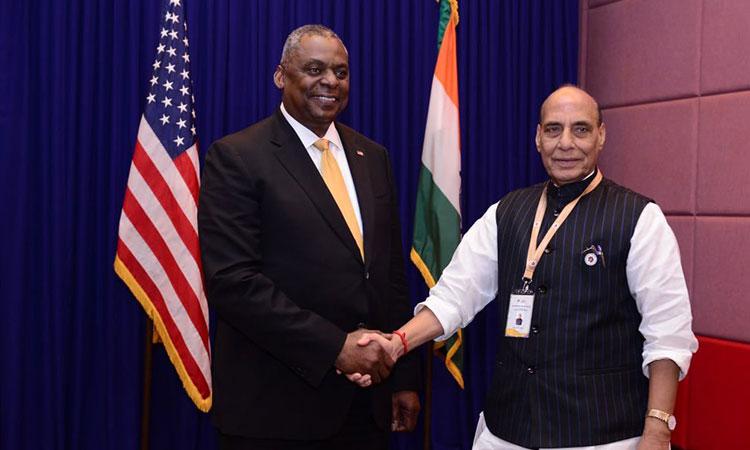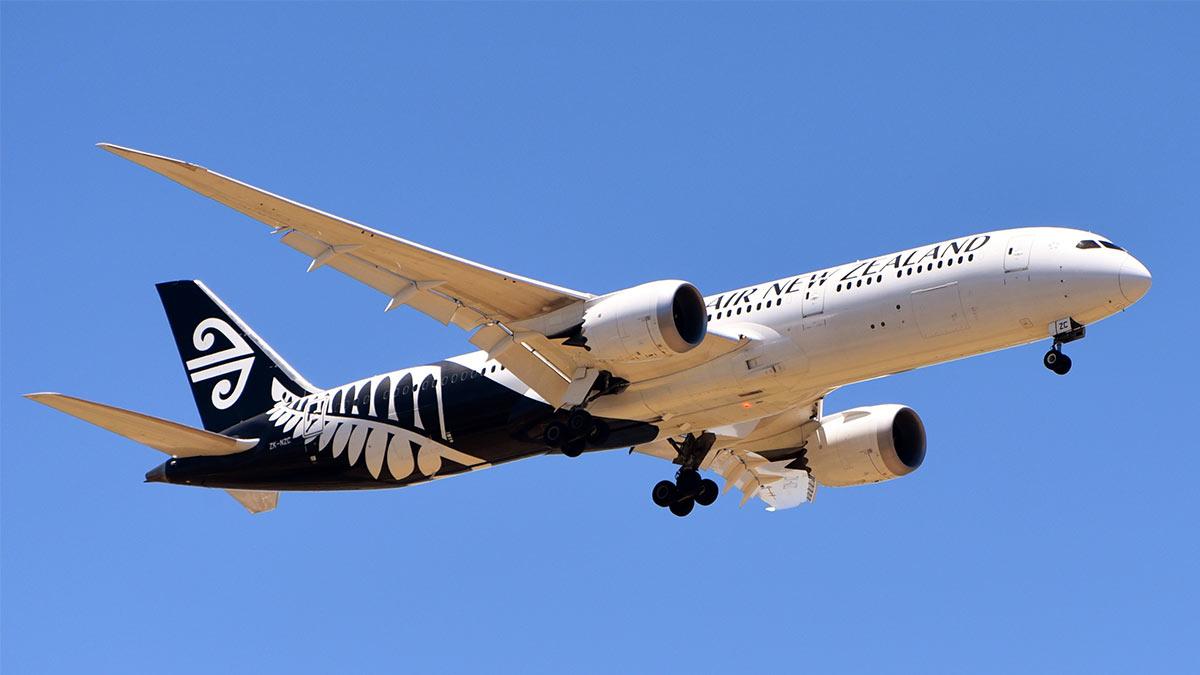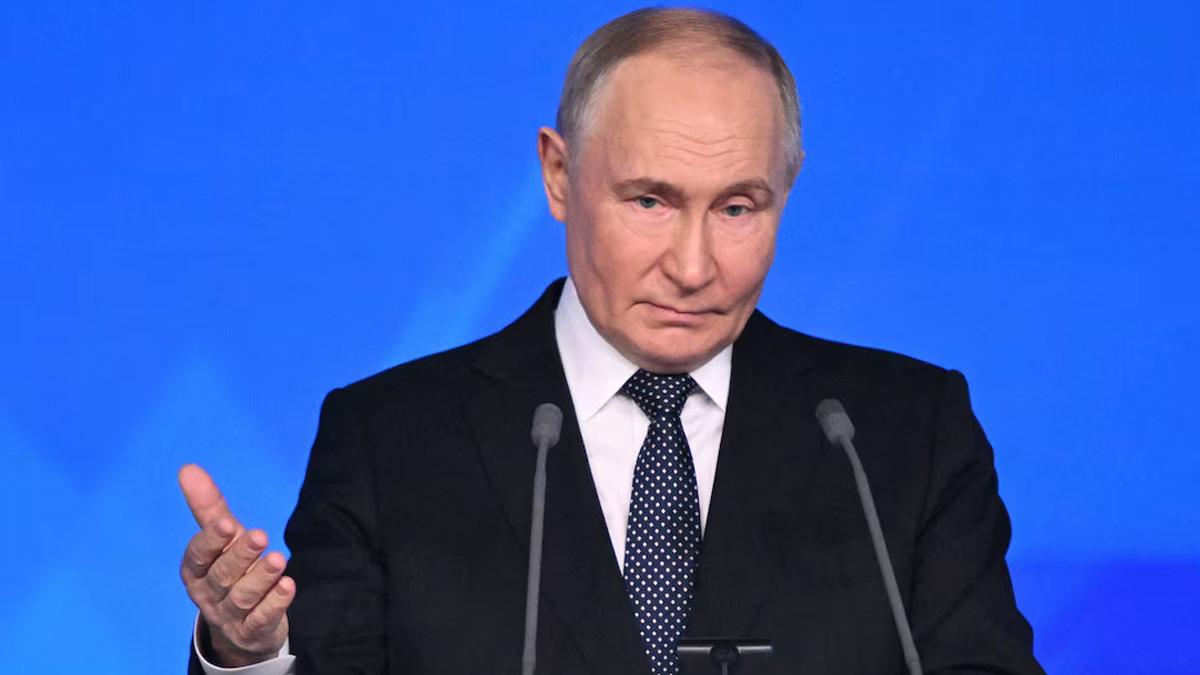The joint production of GE's F-414 jet engines in India announced during Prime Minister Narendra Modi's state visit to the US in June is a game-changer.
It bears testimony to the growing centrality of defence in the bilateral relationship between the two countries, driven in part by shared concerns about an aggressive China.
Additionally, India ordered General Atomic's MQ-9 armed drones during this visit that will significantly enhance its ISR (intelligence, surveillance and reconnaissance) capabilities. These will be assembled in India.
The two sides also concluded Master Ship Repair Agreements that would allow forward deployed US navy ships to dock in India for repairs and agreed towards the creation of logistic, repair, and maintenance infrastructure for aircraft and vessels in India.
A joint statement released by the two sides after Prime Minister Modi's meetings with President Joe Biden contained many new initiatives -- around 25 -- across an entire range of sectors including the opening of new US consulates in India and stateside H-1B renewals (Indians are the largest beneficiaries of the program), but the F-414 joint production clearly stole the show.
India has been trying to develop a jet engine for its fighter jets for decades but unable to make much headway, it has been using GE's F404 for its Tejas fighters. F414 will power the next generation of Tejas fighters.
Under the MoU signed by Hindustan Aeronautics Limited and GE, F414 engines will be jointly produced in India, which would entail the most significant transfer of US military technology to India, a remarkable capstone for a defense relationship that did not exist 20 years ago.
India, which is the world's largest importer of arms, bought nothing from the United States till 20 years ago. By 2020, it had bought $20 billion worth of American equipment, accounting for 10 per cent of its arm imports; the total is now nearing $25 billion.
According to a list compiled by the Congressional Research Service, a non-partisan body that provides policy research to US lawmakers, India's purchases over the years span all three platforms, but majorly air and sea:
Air
- 28 AH-64 Apache combat helicopters (22 delivered)
- 1,354+ AGM-114 Hellfire anti-tank missiles
- 245 Stinger portable surface-to-air missiles
- 12 APG-78 Longbow combat helicopter radars
- 6 spare helicopter turboshafts
- 15 CH-47 Chinook transport helicopters
- 13 C-130 Hercules transport aircraft (12 delivered)
- 11 C-17 Globemaster heavy transport aircraft
- 2 MQ-9A Reaper UAVs (two-year lease in 2020)
- 512 CBU-97 guided bombs
- 234 aircraft turboprops (228 delivered)
- 147 aircraft turbofans (48 delivered)
Sea
- 1 Austin-class amphibious transport dock
- 24 MH-60R Seahawk ASW helicopters (3 delivered)
- 12 P-8 Poseidon patrol and ASW aircraft
- 48 Mk-54 ASW torpedoes (32 delivered)
- 6 S-61 Sea King naval transport helicopters
- 53 Harpoon anti-ship missiles
- 1 Harpoon Joint Common Test Set (accepted)
- 24 naval gas turbines (6 delivered)
Land
- 12 Firefinder counterbattery radars
- 145 M-777 towed 155mm howitzers (41 delivered)
- 1,200+ M-982 Excalibur guided artillery shells
- 72,400+ SIG Sauer SIG716 assault rifles.
India used to buy most of its defense equipment from Russia (earlier Soviet Union) once. But it has been steadily cutting it down and by 2022 it was down to 45 per cent, according to a report by the Stockholm International Peace Research Institute (SIPRI). France was India's second largest arms seller with 29 per cent and the US third with 11 per cent.
Washington has sought to boost its arms sales to India by removing regulatory barriers in recent years. It declared India a "Major Defense Partner" in 2016, facilitating technology sharing to a level commensurate with the closest US allies and partners.
In 2018, the US granted India the status of STA 1 (Strategic Trade Authorization 1), which brought India at par with NATO member countries and five close treaty allies of the US -- Australia, New Zealand, Japan, South Korea and Israel) for license free import of sensitive dual use technology.
India, on its part, shed years of hesitation to sign the four Foundational/Enabling Agreements -- General Security of Military Information Agreement (GSOMIA), Logistic Support Agreement (LSA), Communications and Information Security Memorandum of Agreement (CISMOA) and the Basic Exchange and Cooperation Agreement for Geospatial Intelligence (BECA) -- that the US says are necessary for interoperability between its military with that of the signatory country.
A legislation moved in both chambers of US congress last month seeks to amend the Arms Export Control Act to expedite arms sales to India, extending it, without mentioning specifically, the same privileges as a group of countries called NATO Plus Five -- Australia, New Zealand, South Korea, Japan and Israel.
The two countries have intensified exchanges and engagements between their militaries as well. India now conducts maximum joint military exercises with the US. Bilaterally, Yudh Abhyas (Army), Vajra Prahar (Army Special Forces), Cope India (Air Force), Tiger Triumph (tri-service). And with multiple other nations along with the US, Malabar (Navy), Rim-of-the-Pacific (RIMPAC, Navy), Milan (Navy), Cutlass Express (Navy), La Perouse (Navy), Sea Dragon (Navy), Pitch Black (Air Force) and Red Flag (Air Force).
If defence cooperation is the engine driving this bilateral relationship, the fuel for it is coming from shared concerns about China.
People's Republic of China found not a single direct mention in the 6,500-word joint statement issued by India and the US after Modi's meetings with Biden, or in the 2,600-word fact-sheet issued by the White House to highlight the important elements of the discussions.
Para 29 of the joint statement, however, left no doubt about about where the priorities lay for the two sides: "a free, open, inclusive, peaceful, and prosperous India-Pacific region with respect for territorial integrity and sovereignty, and international law," it emphasised.
"Both leaders expressed concern over coercive actions and rising tensions, and strongly oppose destabilizing or unilateral actions that seek to change the status quo by force," the para went on to say, referring, without naming names and events, China's pursuit of maritime and territorial claims in the region that hat led to tensions and conflicts with several countries including India, Japan, Philippines and Indonesia.
"Both sides emphasised the importance of adherence to international law, particularly as reflected in the United Nations Convention on the Law of the Sea (UNCLOS), and the maintenance of freedom of navigation and overflight, in addressing challenges to the maritime rules-based order, including in the East and South China Seas,” the statement said further, referring to China’s rejection of a 2016 ruling of the panel.
China cast a shadow on the Modi visit."Clearly, the challenges presented by the PRC to both our nations were on the agenda yesterday," White House national security council spokesperson John Kirby told reporters a day after Modi-Biden meetings.
But he rejected suggestions that Modi's visit was intended to leverage India as a counterweight against China. But it’s no secret here in the US or in India that the threat from China is pushing the two countries closer like nothing else.
China has also brought India closer to Australia and Japan, as members of the Quad, alongwith the United States. Though resurrected in 2017 after it folded up in 2008, India participated enthusiastically in its revival after the Galwan border skirmishes with Chinese troops -- New Delhi’s hopes of friendly relations with Beijing were rudely broken.
Quad has since taken off, with the second in-person summit level meeting of its leaders taking place earlier on the sidelines of the G-7 meeting in Hiroshima.
Defence and security matters are not covered by the Quad, they are not only front and centre in the bilateral India-US ties, but are, in fact, driving it and, once again, in no small measure because of China.
Also Read | Once China divided India and US, now it brings the two nations closer
Also Read | Yellen’s China visit seeks to balance Biden’s unprecedented red carpet for Modi


















